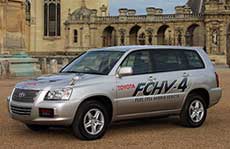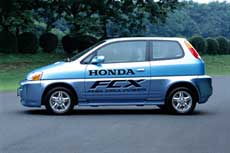Let's take a look at the characteristics of the different types of eco-cars.
| |

A Toyota Corolla van that runs on natural gas.

A Toyota RAV4L V electric car.
|
| |
|
Natural gas cars Cars that
run on natural gas emit 25% less carbon dioxide than gasoline-powered
ones and close to zero harmful substances. They have less power than
gasoline cars, though, and the fuel tank is bulky.
Electric cars Electric
cars rely on a battery that is charged between uses. Because they burn
no fuel, they emit nothing at all. When they were first produced, the
distance they could travel on a single charge was quite short, but this
has improved recently, and they are becoming more practical. One problem
with electric cars, though, is that the battery is expensive, making
the car itself expensive. In Japan at present, these cars are used mostly
by companies and government offices. There are also car-sharing experiments
in which people in the same neighborhood use the same electric car.
| |

A Toyota Prius hybrid car.
|
| |
|
Hybrid cars Most hybrid
vehicles make use of an efficient combination of a gasoline engine and
an electric motor. For example, when the car comes to a stop at a red
light, the engine is automatically switched off in order to prevent
harmful emissions. When the car begins to move after the light turns
green, it relies on the motor while the engine gets started again. The
electric motor reduces the burden on the engine when the car accelerates,
enabling the car to emit less nitrogen oxide. Japan has been a world
leader in hybrid technology, and the nation exports a large number of
these vehicles. The Toyota Prius and Estima Hybrid and the Honda Civic are
available as hybrid models.
| |

A Toyota FCHV fuel-cell car.

A Honda FCX fuel-cell car.
|
| |
|
Fuel-cell cars The fuel-cell
car, which has been called the ultimate eco-car, is still in the development
stage. This type of car works by chemically combining hydrogen fuel
with oxygen from the air to produce electricity. The only byproduct
emitted by a fuel-cell car is a small amount of water.
Hydrogen explodes rather easily, however, and it would be quite
dangerous for a car loaded with it to get into a traffic accident. In
addition, the tank needed to hold the hydrogen is very bulky. These
factors have led some people to the conclusion that it is more realistic
to use methods that extract hydrogen from other fuels, such as natural
gas or methanol. By using these sorts of fuels, the amount of harmful
substances that are emitted will be much less than what is produced
by a gasoline-burning vehicle.
In the United States a method of creating electricity using hydrogen
extracted from gasoline is being studied. While some harmful substances
will still be emitted and petroleum will still be needed, this method
is advantageous in that existing gas stations can be used to supply
the fuel. Japan's Toyota Motor Corp. and America's General Motors and
Exxon Mobil have made clear that they intend to work together to develop
a fuel-cell vehicle that uses this method.
Photos: Toyota Motor Corp. (top, second, third, and fourth); Honda Motor Co. (bottom) |